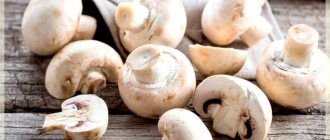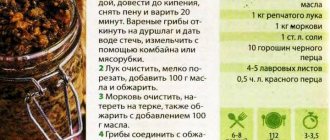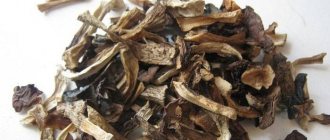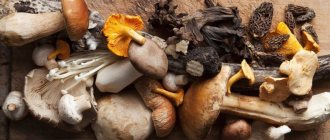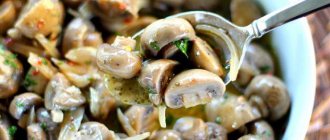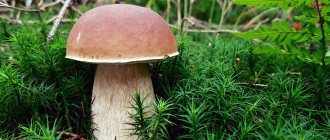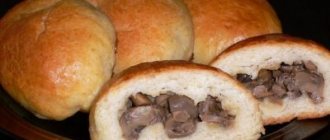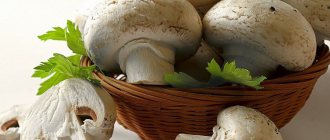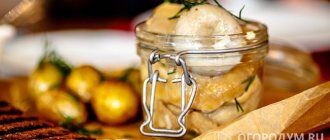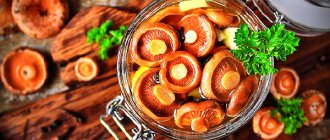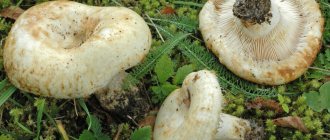Cooking tips
To store salted mushrooms at home for a long time, you should know certain culinary subtleties. After all, if prepared incorrectly, this product can quickly deteriorate.
Method one
- After salting, the liquid must be drained.
- Dry the mushrooms on a paper towel and place in portions in a plastic bag or cling film.
- Then place the preparations in the freezer. The product will not lose its taste even after long-term storage. After defrosting, the mushrooms can be eaten immediately.
Method two
- After the mushrooms are pickled, they must be washed thoroughly.
- Boil fresh brine. Place mushrooms in it and boil for 2-3 minutes.
- Place them in a pre-sterilized jar and pour in hot brine.
- Roll up and let sit in brine for about 7 days in the refrigerator.
- Then drain the liquid and pour vegetable oil over the prepared mushrooms. Thanks to the oil, the product will not mold and spoil.
- Before eating mushrooms, the oil must be drained.
Method three
- After salting, place the mushrooms in glass jars.
- Press them down with your hand so that all the air comes out. This is necessary for long-term storage, since due to the voids in the jar, fungus will form, which will lead to damage to the workpiece. The mushrooms should reach the top of the jar.
- Take a container, pour vodka and wet a cotton cloth with it (it is very important that the cloth has a diameter twice as large as the volume of the jar).
- Place this fabric on top of the product, and use wooden sticks placed crosswise over the shoulders of a can, for example, from an ice cream container, to create pressure.
- The brine should extend above the mushrooms, covering them by 1.5 cm. If it is not enough, add brine (30 grams of salt per 1 liter of water).
- Close the jar with a tight plastic lid. Its sides must first be soaked in vodka.
- Shelf life - up to 1 year.
- Remove the top layer from each champignon cap, rinse thoroughly and wait until the water drains. Place them in a bowl and sprinkle with salt, mix everything thoroughly.
- Peel the onions and chili peppers and cut into rings.
- Place the ingredients in sterilized jars in the following order: onion-pepper-champignons. It is imperative that the final layer be champignons.
- Fill the workpiece with oil. If desired, add spices to taste and seal the jar.
- All you have to do is marinate the appetizer for a week, and you’re ready to eat.
Storage without seaming
The shelf life of salted mushrooms without preservation is up to 12 months, in the refrigerator. Unsterilized pickled mushrooms, unopened, will be good for about 8 months.
They will keep in the refrigerator for about a month. In tubs - six months with temperature conditions of 0-2 degrees Celsius.
Homemade preparations are best stored in glass and enamel containers, but not in warm places. And they are necessarily covered with brine. When the liquid evaporates, you need to make a new solution with a proportion of 50 g of salt/1 liter. boiled water.
Important! Some housewives use melted lard and pour it over mushroom pickles.
You can also use sunflower oil. After filling, the containers are tied with gauze. The jars are covered with not very tight lids made of glass or metal.
You can even drain the brine liquid and fill the mushrooms with fat. They are stewed or fried; salted mushrooms should be stored in this form in rooms without access to light.
You can also compact the salted mushrooms tightly into jars and cover the top with cotton napkins. These napkins must first be dipped in vodka. Then there will be no mold.
Then the surface of the cans along with the napkins should be pressed with chopsticks treated in vodka, cross to cross. They will act as oppressors. Liquid should appear on the surface.
If it doesn’t exist, you can make a saline solution again - 1 liter/50g. Spray the plastic lids with vodka and close the jars. If stored in dark and cool places they will last from 1 to 1.5 years. If mold appears, you need to remove it with a napkin and vinegar.
Important! Before use, such mushrooms are digested and salted or marinated again.
Another condition is that the mushrooms be in a salty solution, but without excess salt, otherwise they cannot be eaten. With a small amount of salt, the mushrooms will ferment. Therefore, you need to use proven cooking recipes to prepare brine.
How to store salted mushrooms at home. General recommendations
Before you start pickling mushrooms, you should take care of the place where the pickles will be stored. Experienced cooks and lovers of quiet hunting recommend:
1. The temperature in the room or refrigerator should be from +2 to +4 degrees. Fluctuations are possible, but no more than 2 degrees in both directions.
2. Below 0 degrees - the pickle will freeze and lose its nutritional and taste value. Above +7 degrees is the ideal temperature for the development of pathogenic microflora.
3. The room must be ventilated and dry.
4. Mushrooms must be in brine. As soon as the product sticks its tip out of the jar, it immediately begins to mold.
5. Do not cover jars and other containers with paper, plastic bags or plastic jars. At temperatures above 0 degrees, water evaporates from the brine. Drops of moisture will accumulate under the improvised lid - this is an ideal environment for the growth of mold and yeast.
6. When salting, it is important to monitor the ratio of salt in the brine. Excess sodium chloride will ensure long-term storage of mushrooms, but will make them inedible. A deficiency will promote the activation of yeast and will cause lactic acid fermentation. The mushrooms will remain edible, but they will be unpleasant to eat.
7. For long-term storage, glass jars, wooden containers, and enamel pans should be used. Important! The material from which the dishes are made must not oxidize!
Other site materials
How long to store dumplings
In Siberia, dumplings are made in whole bags and stored all winter. Find out how long you can store ready-made dumplings in the refrigerator
How long does protein last?
Whites sometimes remain after cooking various dishes... Introducing our new article on storing chicken egg whites
Pickling mushrooms is a common and reliable way to preserve the harvest.
Homemade preparations are not only tasty, but also convenient to use. You can prepare many different dishes with salted mushrooms. In this article we will talk about how to properly store salted mushrooms.
Source: depositphotos.com
The first important condition for long-term storage of salted mushrooms is the sterility of the dishes. If bacteria get into the container, the salted mushrooms will spoil even if other conditions are met. Glass and ceramic containers are sterilized, and pots, buckets and barrels are thoroughly washed, scalded with boiling water and dried.
The next significant point is temperature. Regardless of the pickling method, mushrooms are stored in a dark, cool, dry place.
Recommended temperature is about +6 °C. Higher rates lead to mushroom souring, and at low temperatures they become brittle and lose their taste. It is best to store salted mushrooms at home in the refrigerator.
Large reserves are kept in a cellar or dry basement (a glazed balcony can also be used for these purposes). To prevent the mushrooms from freezing, they are insulated with old blankets, sawdust, etc.
You can only eat mushrooms that you are 100% sure are safe. Spoiled mushrooms, moldy or improperly prepared preserves can be fatal!
Another point that affects long-term storage of salted mushrooms is brine.
If the product is stored in brine, turn the stock once a week to ensure the brine moves and thoroughly saturates all the mushrooms.
A container for storing salted mushrooms is also of great importance. Glass, wood and enamel containers should be used; Avoid clay, galvanized tin, aluminum or plastic utensils. Do not cover mushrooms with plastic, cellophane or parchment paper - this is an ideal environment for the growth of mold and yeast.
Source: depositphotos.com
The most popular recipes for pickling mushrooms
Probably, every family has its own traditions of preparations - “grandmother’s” secrets, passed on to subsequent generations.
Barrels made of untarred wood or ceramic tubs have long been considered the best containers for pickling; now mushrooms are most often salted in an enamel pan or in a plastic bucket
The most common and accessible methods are cold salting methods, which allow you to preserve as much as possible the beneficial properties of the valuable mushroom product. The technologies are simple, but the cooking process is quite lengthy and is based on natural fermentation. The mushrooms are actually cooked in their own juice, gradually salting and acquiring a piquant sourness, while their flesh remains dense and elastic.
A simple recipe for cold pickling in your own juice
Any mushrooms can be prepared using the cold method, but the correct ones for such pickling are saffron milk caps, milk mushrooms, trumpet mushrooms, russula, and champignons. Ready-made pickles turn out to be very tasty; they are served as an independent snack, seasoned with chopped onions and seasoned with vegetable oil, or added to various meat and vegetable dishes.
Number of servings/volume: 3 l
Ingredients:
- fresh mushrooms – 5 kg;
- rock salt – 200-250 g.
technology :
- Mushrooms are cleaned of debris and impurities, and if necessary, washed under running water immediately or after a short soaking (no more than 20-30 minutes). Pure mushrooms are sorted by size, large ones are cut into pieces. Some housewives additionally recommend quickly pouring boiling water over them or blanching them in boiling salted water (1 teaspoon per 1 liter) for 3-5 minutes. Before pickling conditionally edible mushrooms, for example, milk mushrooms, russula or volushek, they must be soaked in cold water from 5-6 hours to 2-4 days, changing the water twice a day.
- Pour a handful of salt into the pickling container and distribute it over the entire bottom. Prepared mushrooms are laid in layers, sprinkled evenly with salt. For saffron milk caps, take 40 g of salt per 1 kg, for all others - 50 g.
- If desired, spices are added between the layers of mushrooms: pepper (black peas and allspice), bay leaf, dill, chopped onion, garlic cloves, dry cloves, horseradish, cherry or blackcurrant leaves. Spices impart different flavors, so their choice and quantity depend on personal preferences.
- After salting, the container is covered with a wooden circle or a flat plate, on which a load is placed. Once the mushrooms have settled, you can add new ones until the container is full.
- Place the container with mushrooms in a cool, dry place, away from sunlight. After 5-6 days the condition of the workpiece is checked. If there is too much brine, you can pour it out, put it in the refrigerator, and then add it back if necessary or use it to make sauces. When there is not enough brine, it is recommended to increase the load or add a small amount of boiled water.
Until fully prepared, the mushrooms ripen in brine in 1-1.5 months.
Traditional hot pickling recipe
Many housewives prefer to pickle mushrooms using the hot method. It is also universal, but is better suited for varieties with dense pulp: white boletus, boletus, aspen and value (they are pre-soaked for 2-3 days, changing the water regularly). Hot pickling is more labor-intensive, but allows you to prepare mushrooms immediately in jars, which are more convenient to store in the refrigerator.
Number of servings/volume: 3-4 l
Ingredients:
- fresh mushrooms – 5 kg;
- rock salt – 10 tbsp. l.;
- bay leaf – 5 pcs.;
- dill (fresh or dried) – 25 g;
- black pepper (peas) – 15 pcs.;
- black pepper and sweet peas – 10 pcs.;
- dry cloves – 10-15 pcs.;
- black currant leaf – 10 pcs.
technology :
- Peeled mushrooms are sorted: for large ones, if they are salted together with small ones, the stems are separated and the caps are cut into several parts, then everything is put in a colander and washed under cold running water.
- Pour water into an enamel pan and add salt to it. The brine is prepared at the rate of 0.5 cups of water and 2 tbsp. l. salt per 1 kg of mushrooms. Place the pan on the fire and bring to a boil. Mushrooms are placed in portions into the boiling brine; during cooking, they are carefully stirred and the foam is carefully removed with a slotted spoon.
- When the contents boil, add pepper, bay leaf and other seasonings to the pan. The cooking time for porcini mushrooms, boletus and aspen mushrooms is 20-25 minutes, for valueu mushrooms - 15-20 minutes, and 10-15 minutes is enough for boletus and russula. Readiness can be determined by the settling of the mushrooms to the bottom and the state of the brine, which becomes transparent.
- Boiled mushrooms are placed in a colander or wide bowl, where they will cool faster. Then they are laid out in jars, filled with the resulting brine and closed. The jars are placed in a cold place (refrigerator or cellar) and left for 40-45 days until the mushrooms are completely salted.
An ancient recipe with combined technology
Those who are interested in forgotten recipes of primordially Russian cuisine and are ready to make some efforts to implement them will be interested in getting acquainted with one of the methods from Elena Molokhovets, combining cold and hot salting technologies.
Number of servings/volume: 3-4 l
Ingredients:
- fresh mushrooms (boletus) – 5 kg;
- rock salt – 250-300 g.
technology :
- Place fresh peeled boletus mushrooms, collected in the fall, in a pot, generously salt them and let them stand for a day, stirring frequently with your hands.
- After a day, pour the released juice into a saucepan, strain through a sieve or cheesecloth, heat it slightly (to a barely warm temperature) and pour it over the mushrooms.
- The next day, the juice should be drained again, heated to a warmer state and poured back.
- On the third day, the drained juice must be heated so that it is quite hot, pour over the mushrooms and leave them for three days.
- After three days of salting, the juice is not drained, but placed directly on the fire with the mushrooms and brought to a boil.
- When the mushrooms have cooled, they are transferred to a jar, pot or oak tub with the caps up, poured with the same brine, and melted (slightly warm) fat on top. The necks of the jars are tied with a bubble (modern housewives can easily use plastic lids).
- In winter, before consumption, salted mushrooms are soaked for several hours in cold water, and then poured with clean water several times and heated on the stove until all the salt is released.
If you salt mushrooms for the winter in this way, then after soaking they turn out very similar to fresh ones and perfectly complement soups, stews and other dishes with their taste and aroma.
